As a young dancer/choreographer, Valerie Bettis burst on the stage with such vividness that she was compared to both Merce Cunningham and Pearl Primus. After she premiered The Desperate Heart in 1943, Edwin Denby wrote that her “vitality on the stage, her technical facility are astonishing, and her composition unusual.” Louis Horst called the piece “the finest modern dance solo of this decade.” Doris Hering dubbed the young dancer “a wild wind” in Dance Magazine.
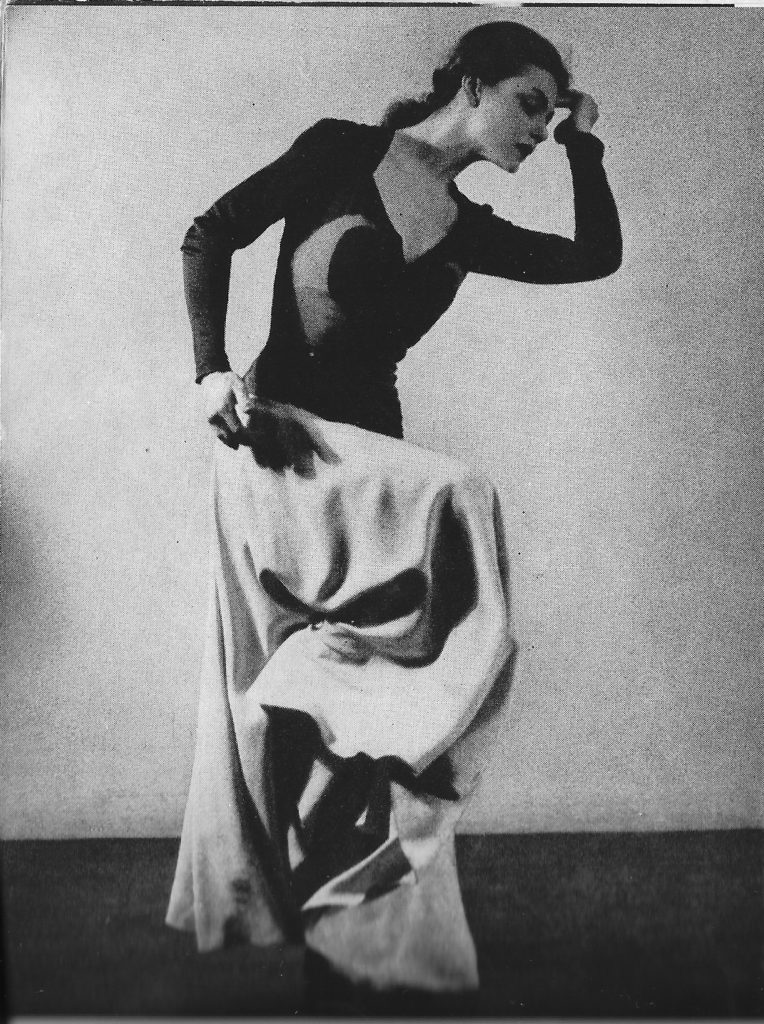
Bettis in The Desperate Heart, photo Gerda Peterich
Bettis danced with a freedom that was at times reckless, but she could also steep herself in a character. When she started choreographing, it was this ability to create a character that defined her style. She gave choice roles to ballet stars like Patricia Wilde, Frederic Franklin, and Virginia Johnson. In Hollywood, she devised steamy numbers for Rita Hayworth (links to clips further down).
She experimented, not in the avant-garde mode, but in other realms: early television, dance-dramas based on literature, and developing the Dancers Studio as a counterpart to the famed Actors Studio (more about that later). Some critics bemoaned her crossover into television and Hollywood, but she had developed a taste for larger audiences and a talent for acting. She kept many plates—and genres— in the air at once.
Early Training
Growing up in Houston, Bettis had plenty of gumption from the start. At an early age, she wanted to study ballet with Rowena Smith but was told she was too young. She admits she “pulled a tantrum,” prompting Smith to tell the girl’s mother, “If she can keep up with the class, I’ll let her stay.” Needless to say, she kept up and then some.
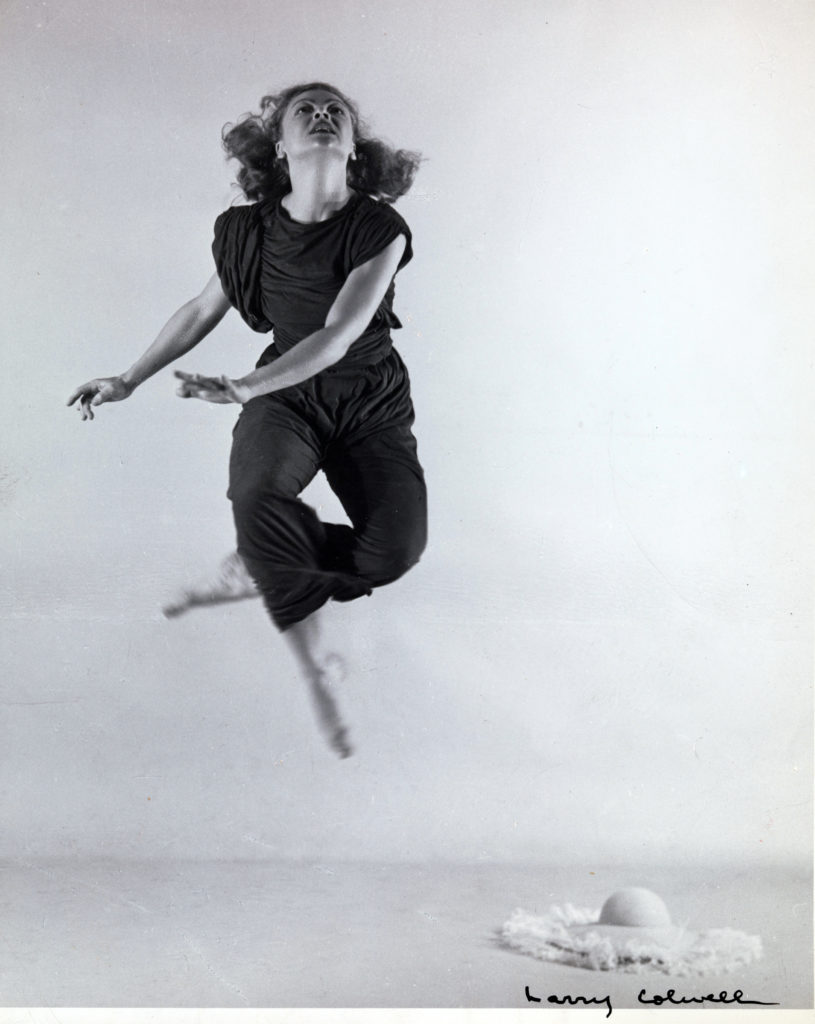
Valerie Bettis, photo by Larry Colwell, Courtesy Jacob’s Pillow Archives
Rowena Smith nurtured Valerie’s talent. She brought in guest teachers, most notably Tina Flade, a German dancer who had studied with Austruckstanz leader Mary Wigman. This was Valerie’s first encounter with barefoot dance, and she considered Flade “exotic.” Flade’s six-week course prepared Valerie for her later immersion in Hanya Holm’s work. Smith also brought Valerie to the West Coast (possibly UCLA), where she saw Dorothy Bird demonstrate Graham technique, took class with Carmelita Maracci, and studied and performed with Myra Kinch. When the Ballet Russe de Monte Carlo came through Houston, she auditioned for the company and was accepted, but her mother nixed it. (Her father had died when she was 13.)
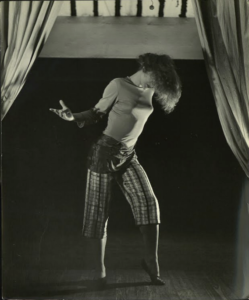
Bettis, photo by Nina Leen, 1948
One year at the University of Texas was enough for Bettis to know that college wasn’t for her. She moved to New York, arriving in 1937. She visited the studios of the three major women modern dance “pioneers”: Martha Graham, Doris Humphrey, and Hanya Holm. But she was inspired only by Holm—possibly because of the Wigman connection. (Holm was chosen by Wigman to set up her school in New York, which was initiated by Sol Hurok. Because of anti-Nazi sentiment, in 1936 the name of the school had been changed from the Mary Wigman School of Dance to the Hanya Holm School of Dance.) Her first exchange with the German choreographer has been oft repeated. When Holm asked why Valerie wanted to study, the teenager replied: “Because I want to be a great dancer.” To which Holm wisely stated, “Well, that will take some time.”
Like Wigman, Holm ran her school with a full palette of technique, choreography, improvisation, and dance notation. Each teacher was grounded in the Wigman approach but had a different style of teaching. “I was darn lucky,” Bettis said in 1979. “It’s rare today to get a variety of temperaments teaching basically the same principles but not doing the same things.”
Almost right away she was taken into Holm’s company. She debuted in Holm’s landmark work Trend that same year. She was such a striking, buoyant dancer that Holm created a duet with Bettis called In Lighter Mood (1946) at her Colorado College Summer School of the Dance. In the documentary film on Holm, Bettis was called her “longtime muse.” In this Facebook posting of the documentary Hanya: Portrait of a Dance Pioneer, you can see two lovely minutes of Bettis dancing, starting at 5:10 minutes in.
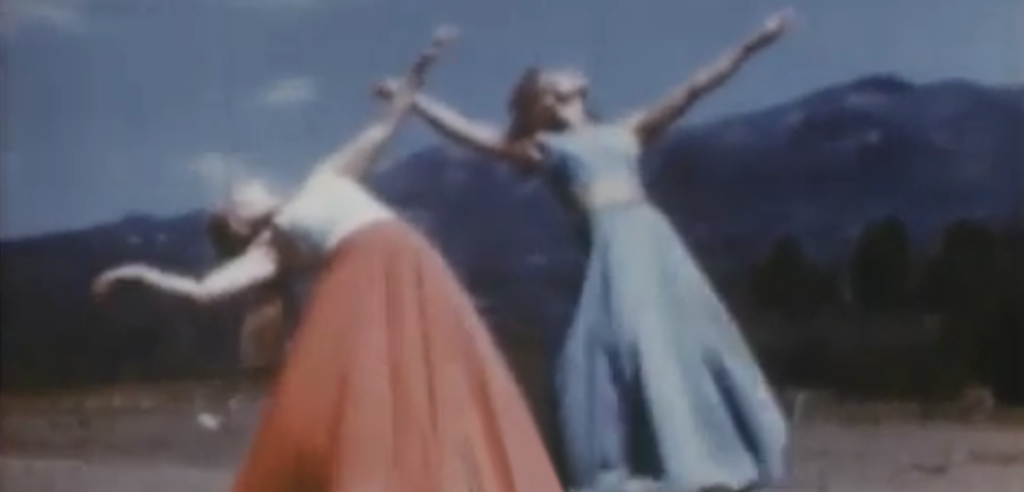
Holm and Bettis in Colorado, 1946, screen grab, Hanya Holm: A Retrospective
However, after three years with Holm, Bettis took time off to work independently. She debuted as a solo artist at Carnegie Chamber Music Hall in November 1941. All the music was by Brazilian composer Bernardo Ségall, whom she later married, and she designed the costumes herself.
The summer of ’42, soon after the U.S. joined World War II, she made her first group work and dedicated it to those “who have suffered the monstrous oppression of the Axis, but whose spirit lives to inspire the free.” That December, in a program shared with Sybil Shearer and Erick Hawkins at the 92nd Street Y, she presented her first durable composition, And the Earth Shall Bear Again, with music by John Cage.
How did she get into acting? Classic story. One of her fellow dancers was auditioning for the 1939 World’s Fair but was too nervous to do it alone. The friend did not make it, but Valerie did. Thus she performed in Railroads on Parade, with music by Kurt Weill, book by Horton Foote, and choreography by Bill Matons. Her partner was Michael Kidd. (Yes, he who choreographed the movie Seven Brides for Seven Brothers.)
The Desperate Heart
In 1943 came her breakthrough as a dancer/choreographer. Bettis premiered The Desperate Heart, with original poetry by John Malcolm Brinnin, at the Humphrey-Weidman studio. Margaret Lloyd, author of The Borzoi Book of Modern Dance, wrote that the dance was “like a haunting melody . . . deeply emotional, changeful, and with the modulations of feeling amplified by words.” John Martin of The New York Times clearly felt she overshadowed the other two dance artists on the program—Erick Hawkins and Pearl Lang: “She has . . . speed without precedent in the modern field, and a temperament that can make the atmosphere fairly sizzle.” He gave the dance his critical award of the year.
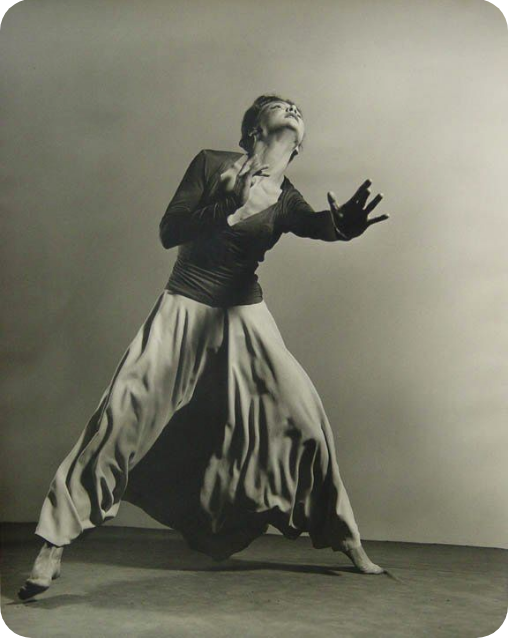
The Desperate Heart, photo by Barbara Morgan
The following January at the 92nd Street Y, Bettis shared a concert with Pearl Primus. Denby effused, though with a slight reservation:
Two young modern dance soloists gave the most dramatic recital that any young dancers have given this season . . . Both are thrilling to watch in motion, and neither has any of the careful academicism that makes many young modern dancers less effective on the stage than in the classroom. They represent a new generation of modern dancers, full of theater vitality . . . [Bettis] is an actress of very great talent, not unlike Bette Davis in her effect . . .To my mind, Miss Bettis has difficulty concentrating on a simple climax and resolution; she hesitates between a lyric and a dramatic form. But she is a dancer of real power and originality.
In the summers of 1946 and 1947, she brought The Desperate Heart, the Cage piece, and other works to Jacob’s Pillow.
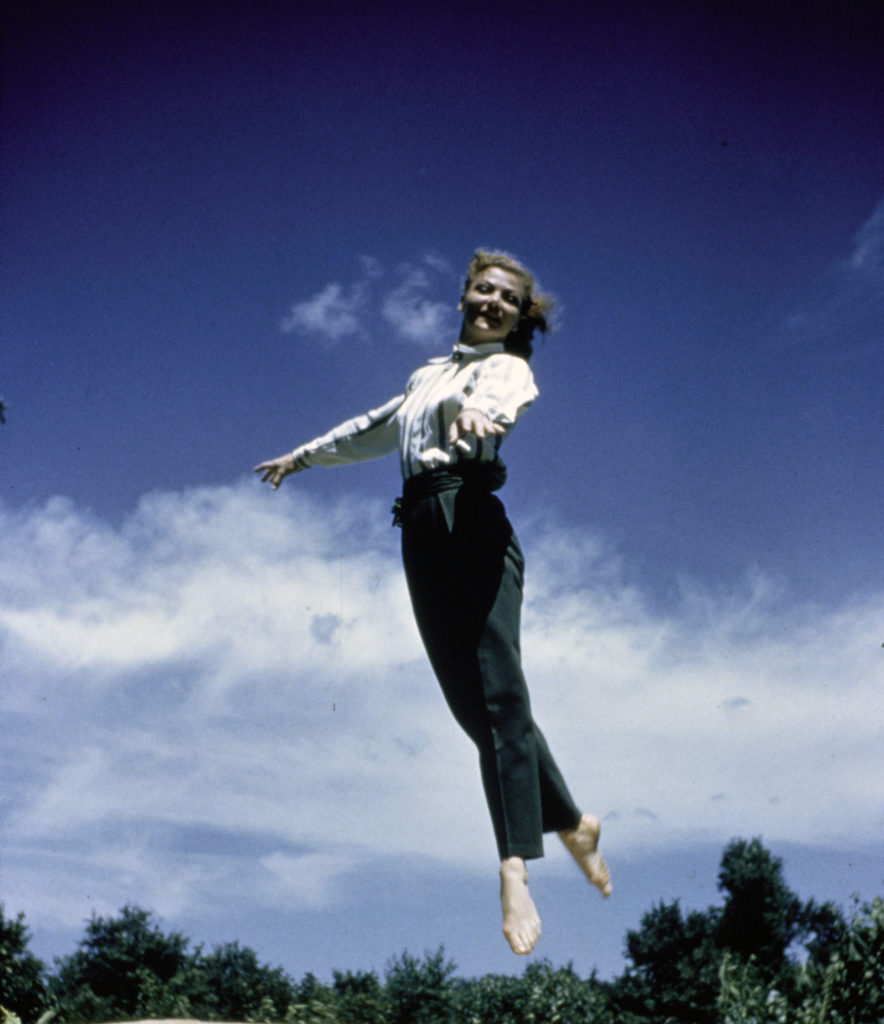
Bettis, photo John Lindquist, c. 1946 © Harvard Theatre Collection, Courtesy Jacob’s Pillow Dance Festival Archives
Television, Broadway, and the Movies
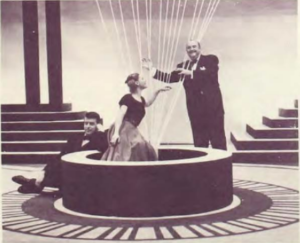
Bettis with Paul Whiteman for his TV series, Dance Magazine Archives
Bettis preferred applying her ingenuity to the demands of television, film, or literature, rather than coming up with an idea from scratch. In the late 1940s she produced dance—often twenty-minute segments— for the early stages of television. In 1949 she worked on a 16-week series of CBS’s Paul Whiteman TV Show:
At CBS I did countless experiments; I was learning and so were the cameramen. It was like a fascinating toy. . . It stimulated another image of movement for me . . . I didn’t want a replica of something for the stage. It was done right then and there for the camera . . . I did 15 minutes of dance very week on that show. It’s gone, but the value to me is mine. The craft and the sheer necessity to produce was wonderful—backbreaking, but wonderful discipline.
As a performer, she was appearing in some of the TV shows she choreographed as well as on Broadway. She was in productions with Walter Matthau, Shelley Winters, Paulette Goddard, Zero Mostel, Colleen Dewhurst, and the list goes on. She danced in two musicals choreographed by Helen Tamiris. The first one, Inside U.S.A. earned her a Donaldson Award (precursor to the Tonys) for best dancer, and a second one for best musical comedy debut. Jack Anderson singled her out in his review:
Broadway took note of Miss Bettis in 1948 when she appeared in the revue “Inside U.S.A.” and scored a triumph in “Tiger Lily,” a number choreographed by Helen Tamiris in which she portrayed a torrid but lethal seductress fond of throwing lovers off cliffs.
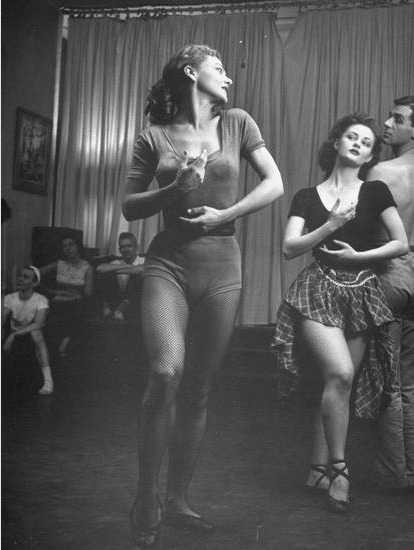
Bettis teaching her part in Inside U.S.A. to her replacement, Beverly Bozeman
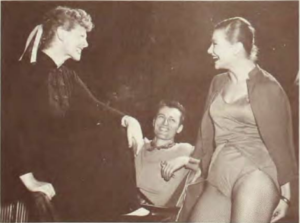
Rehearsal for Bless You All, From left: Helen Tamiris, Daniel Nagrin, Bettis, Courtesy Dance Magazine Archives
Her second stint with Tamiris, Bless You All (1950), was the first time she was asked to sing onstage. Her partner was Donald Saddler, who appeared in several later projects with her. (Assisting Tamiris was her husband, Daniel Nagrin, another notable choreographer.)
In 1958, Bettis choreographed for Ulysses in Nighttown (1958), based on James Joyce’s Ulysses. The following year, in the London version, she played the female lead opposite Zero Mostel. Her reputation as a triple threat reached such heights that she was chosen to replace Lotte Lenya in The Threepenny Opera (no doubt her throaty voice helped.)
During the ’50s Bettis continued to work in television. As either a choreographer or actress, she worked with Bing Crosby, Mary Martin, Paul Newman, Frank Sinatra, and many other household names. In the series called Playwrights 56, she appeared in Faulkner’s The Sound and the Fury with legendary actresses Ethel Waters and Lillian Gish.
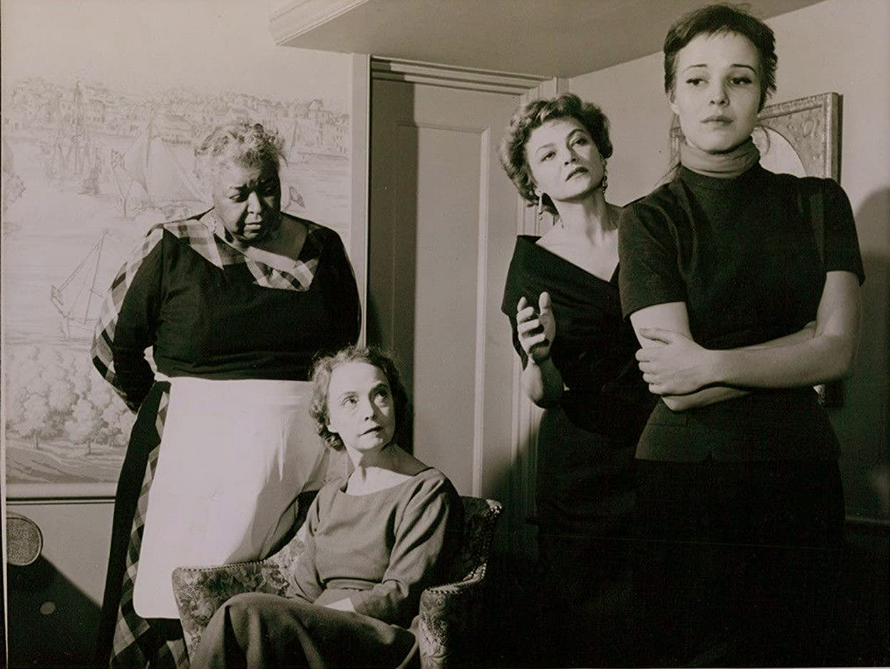
From left: Ethel Waters, Lillian Gish, Bettis, and Janice Rule, in The Sound and the Fury
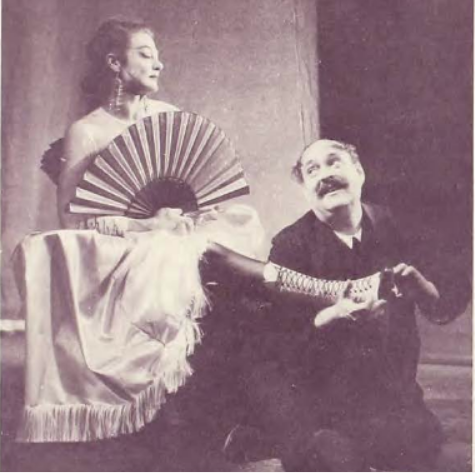
Bettis with Zero Mostel, Ulysses in Nighttown, London, 1959
In Hollywood, Bettis choreographed for Rita Hayworth on two films: Affair in Trinidad (1952), in which Bettis herself also appeared, and Salome (1953). In the first, both the “Chica Boom” number and “I’ve Been Kissed Before,” have plenty of jazzy pelvic action as well as modern dance shapes. The fabulously raunchy result earned the insult “vulgar and grotesque” from Bosley Crowther of The New York Times. Salome featured Hayworth in “Dance of the Seven Veils,” a high-class cousin of a strip-tease. Bettis and Hayworth would work for weeks on each number. About the movie star, she said, “I loved Rita. Very unpretentious. Worked every day, you know; she really did class with me and worked very, very hard.”
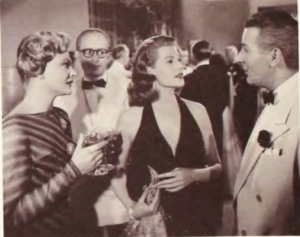
Bettis and Hayworth in Affair in Trinidad, Dance Magazine Archives
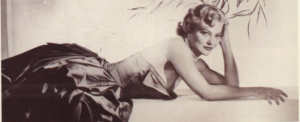
Bettis’s Hollywood publicity shot, Courtesy Dance Magazine Archives
First Modern Dancer to Choreograph for a Ballet Company
Bettis believed that it was her television work that led Serge Denham to ask her to choreograph for the Ballet Russe de Monte Carlo. However, Margaret Lloyd suspected that it was John Gay’s Beggar’s Holiday (1946), her first Broadway musical, that did the trick. With music by Duke Ellington, this show had an interracial cast that included Marge Champion, Lucas Hoving, and Lavinia Williams. Bettis’s choreography combined ballet, modern, and jazz dance.
In any case, Virginia Sampler opened in 1947, touted as the first ballet by a modern dancer. (Agnes de Mille, considered more of a ballet dancer, premiered Rodeo with the same company in 1942.) The setting was the state of Virginia after the Revolution, when outsiders started to settle on their land. It had a stellar cast of Marie-Jeanne, Patricia Wilde, Frederic Franklin, and Leon Danielian—although some critics felt that Bettis herself, playing the Unidentified Lady on Horseback, outshone the others. Although the ballet was not a success, Wilde relished her role as the malevolent Mother “almost more than anything else she danced with the company,” according to her biographer, Joel Lobenthal.
Critic George Amberg wrote that Bettis’s “different kind of dance impulse” clashed with ballet training, and he called the result “altogether unsatisfactory.” Lloyd wrote that the failure was “much to the gloating of those who opposed the union [of ballet and modern dance], and to the disappointment of those who approved it.”
Bettis fared no better at American Dance Festival in 1949. She premiered two text-heavy dance-theater works: It Is Always Farewell, which was described by critic Nik Krevitsky as “vague in theme and characterization;” and Domino Furioso, with text by Brinnin that prompted John Martin to quip, “If Miss Bettis is not careful she will talk us all to death.”
A Streetcar Named Desire
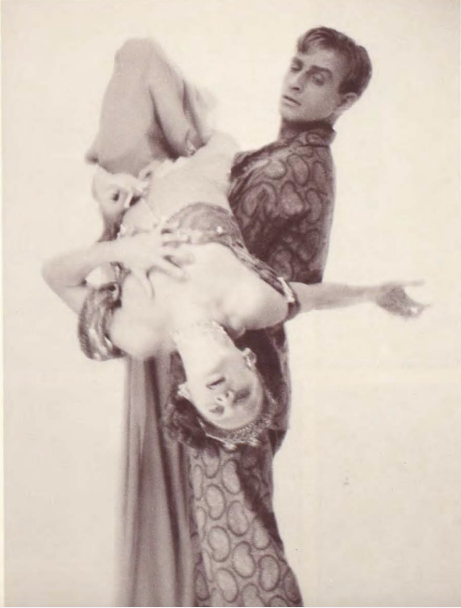
Franklin and Slavenska in Streetcar (1952), Dance Magazine Archives
Although the critical reaction to her first ballet was dismal, Frederic Franklin thought Bettis was ahead of her time. For his new endeavor, the Slavenska-Franklin Ballet, he wanted a ballet version of Tennessee Williams’s great American play, A Streetcar Named Desire. When Antony Tudor got cold feet about doing it, Freddie called Valerie. To quote Franklin, she replied, “What, Streetcar Named Desire? Oh, I don’t think so. When do we start rehearsals?”
Streetcar opened in Montreal in October 1952. According to Leslie Norton, when it came to New York in December, it “marched off with the laurels.” Martin wrote that the climactic scene “delivers a wallop that you are not likely to forget.”
Again, Bettis created vivid roles that the dancers could sink their teeth into. For the role of Blanche, Terry wrote that Bettis “has let a gesture of nervousness grow into wild actions which bare a shattered spirit.” Franklin, long and lean, gentlemanly in every role, was cast against type. According to Norton, he “startled the ballet world” by creating “a brutal, loutish character.”
But Franklin himself was worried about the role:
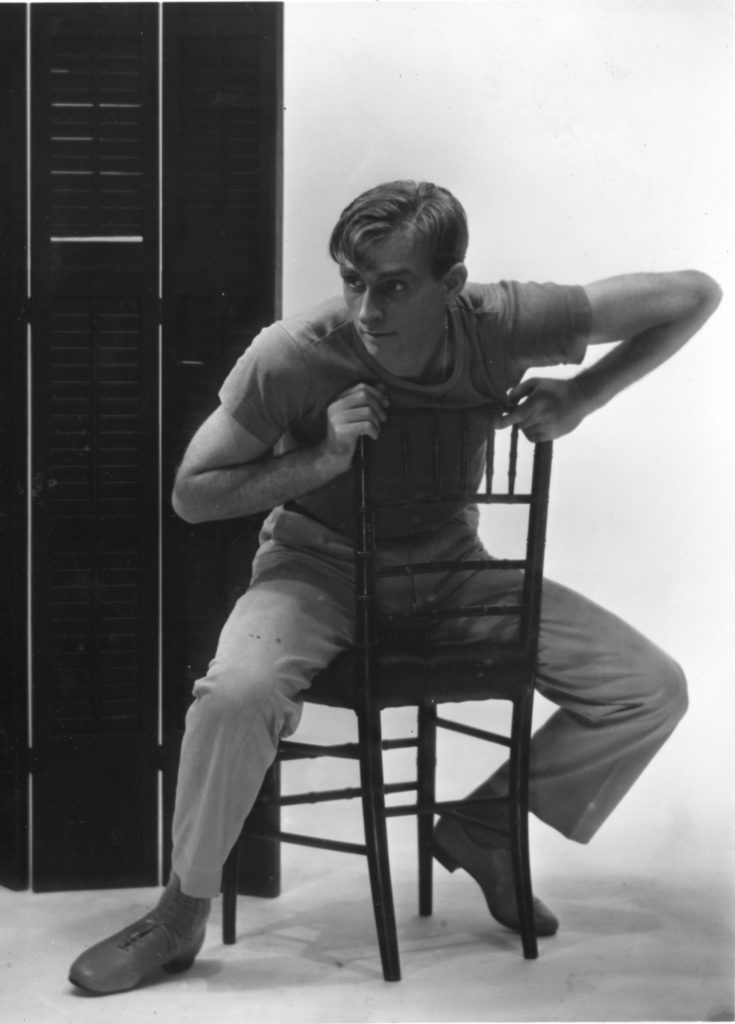
Franklln as Stanley, photo Marcus Blechman, Courtesy Dance Magazine Archives
It was Mia’s [Slavenska’s] idea to do this. I said, “Mia, its fine for you, but what about me and Stanley?” I worked with Valerie. We started with me. And she said, “Freddie, if you’ll just let me go right in and bring it out, we can make this work.” I said, “Valerie, I’m wide open.” And I worked so closely with her. She was living in a lovely studio in the Village and one night, I got a phone call at four o’clock in the morning. “Freddie, come down immediately. I’ve got the Stella theme all worked out.” And I got a taxi, and we worked and worked. And I was on the floor and I was all over the place and at the end she said, very wisely, “Now Freddie, can you do this eight times a week?” And I said, “Well, I’ll break my neck, but I’ll do it, because what you’ve done here is so wonderful.”
John Martin deemed it “the finest performance of his life.”
Two years later Ballet Theatre (later ABT) took on Streetcar briefly. Bettis herself played Blanche and Igor Youskevitch (“dreadfully miscast,” according to Leslie Norton) played Stanley. In 1955, Nora Kaye, known for her portrayals of dramatic heroines in Tudor ballets, took on the role of Blanche, leading Martin to muse that some ballet goers “would like to see Miss Kaye quit suffering for a spell.”
Critic Robert Coleman, however, opined that Streetcar would “rank with Antony Tudor’s magnificent Pillar of Fire among the top-drawer modern works.” Posterity has proven otherwise. I suspect the ballet was too heavily laden with drama to last into our current century.
But after Streetcar Bettis was busy all the time. She might be doing an acting gig in one city while racing to another city to choreograph. “I was my own agent,” she said. “I wrote all my letters. Signed them A. Adams. Booked myself and toured.”
The Dancers Studio
Bettis was so committed to what she called “danced theater” that she formed the Dancers Studio in the image of the famed Actors Studio. The latter was a place where actors, directors, and playwrights could collaborate to create something new. Based on the inner-truth-seeking approach of the Stanislavski method, the Actors Studio gave us Marlon Brando, Lorraine Hansberry, Bradley Cooper and many others. Jerome Robbins was one of the few dance artists to get involved, and it steered him toward his famously intense demand for authenticity from his dancers.
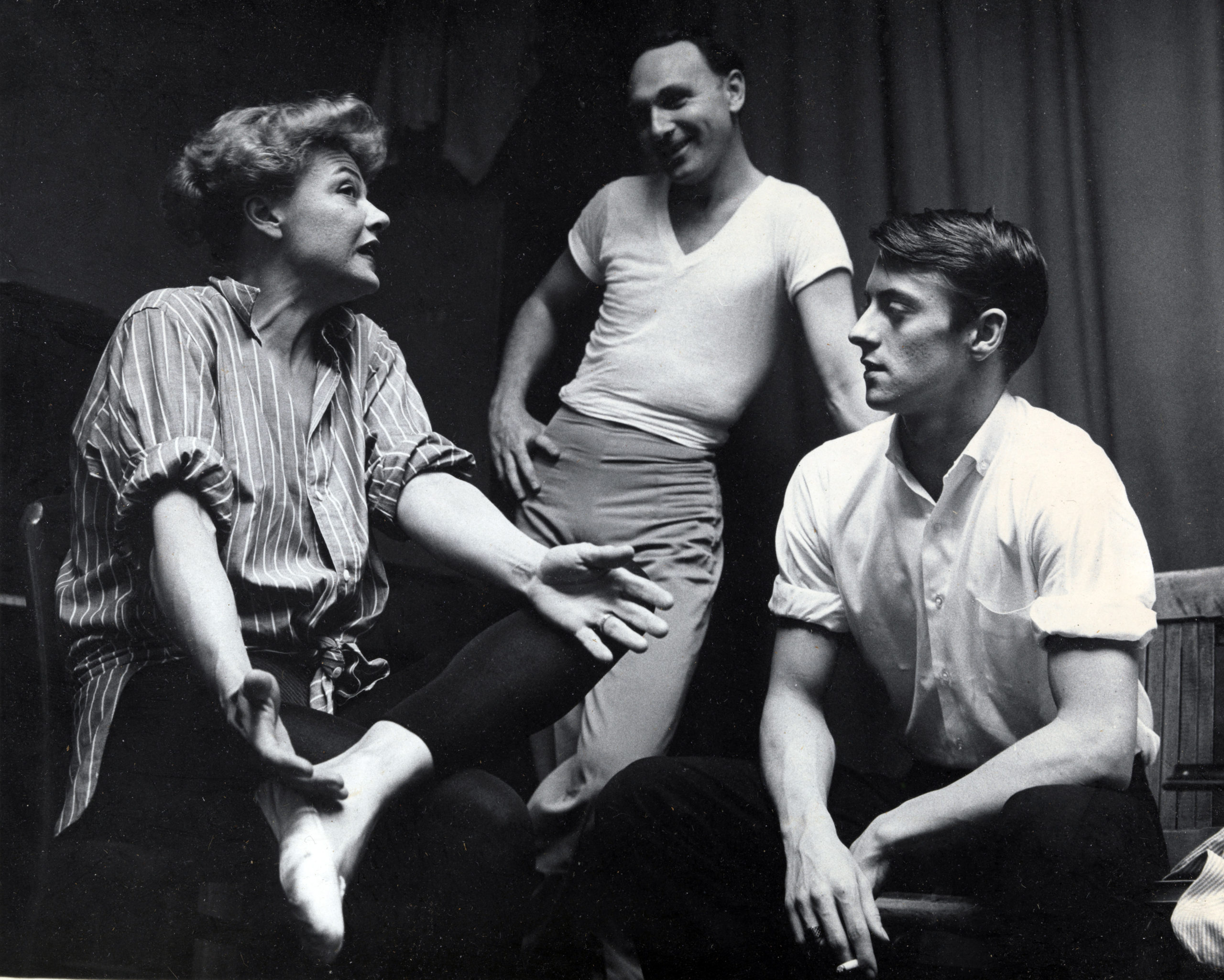
Valerie Bettis, Donald Saddler, Grover Dale, who were both performing with her at the time, 1960, Courtesy Jacob’s Pillow Archives
During the peak years of the Dancers Studio, 1964 to 1968, dance writer Deborah Jowitt participated fully. An actor before she was a dancer or writer, Jowitt felt at home in this context, where Bettis brought in guest directors and writers. “Valerie was groping to get something together that would rival the Actors Studio,” Jowitt told me. “She wanted to do acting and dancing and singing and train us and get us jobs . . . She kept decrying modern dance because you got to perform something once, if that.” One of the guests, director Clinton Atkinson, was so impressed with Jowitt’s abilities as a dancer, choreographer, and actor, that he placed her in several plays and musicals. She was also given the chance to choreograph two of her own works that Bettis produced. “So, in my career, what Valerie started pushed me in new directions.”
Other notable dance artists who were part of the Dancers Studio include Jeff Duncan, Clyde Morgan, and—though fleetingly—Carolyn Adams, who danced in a piece by French choreographer Brigitte Réal.
Because of the varied projects that were seeded at the Dancers Studio. Jowitt says. “It seemed that what we were doing was very fertile.”
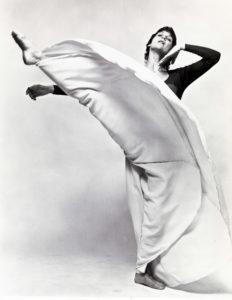
Beals in The Desperate Heart, 1975, photo Meg Hunnewell, Courtesy Jacob’s Pillow Archives
Margaret Beals, another member of the Dancers Studio in the ’60s, felt that Bettis was “a pioneer of integrating the spoken word with dance.” The opportunity arose a decade later for her to perform The Desperate Heart, specifically so the dance could be filmed for posterity. The choreography, she said, was “very motivated physically, like Graham, but more human, less archetypal, less heroic.” The visceral movement sometimes required a strength she found challenging: “There’s one jump where you’re in a low fifth-position plié and you’re holding your fingers locked together with your elbows high, and as you push off into an attitude jump, you flip your hands apart out of the anguish.” Once she felt the anguish fully, the difficult jump became possible.
Even six decades later, Beals’s impression of Bettis had not dimmed:
I thought of her as a powerhouse, a tiger. Valerie had an actress energy, an emotional energy. Very sexual. Mesmerizing. She had real star quality, which wasn’t useful to the modern dance field. She was magical and beautiful, but she had a lot of brains and and could choreograph with a motivated power and brilliance.
In the film linked above, both the 55-year-old Bettis and the young Margaret Beals are interviewed by critic Walter Terry. Bettis describes how she wanted the solo to go back and forth in time—“not to be trapped” in a single emotion. Beals notes that although they used improvisation differently (Beals was a master improvisor in her day), “We have the same relationship to movement coming from the spirit of the moment.” After the interview, we see the lyrical Beals perform the solo, revealing how dynamic the gestures are. Bettis’s low, smoky voice reading the Brinnin poem is slightly reminiscent of Gertrude Stein’s recordings but with more of a theatrical dollop. To my eye, Beals’s performance is magnificent, bringing alive a piece that Terry pronounced a classic of modern dance.
American Dance Company
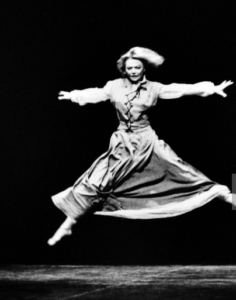
Bettis in As I Lay Dying
During that same period, José Limón decided to create a repertory company to promote modern dance (not unlike today’s Paul Taylor’s American Modern Dance Company). He chose works by the notable modern dancers of the day, including Limón and Doris Humphrey (of course), and Donald McKayle, Anna Sokolow, Merce Cunningham, Alwin Nikolais, Pearl Lang—and Valerie Bettis.
The American Dance Company, hosted at Lincoln Center, lasted only one season. It was well attended, but there was no sustained funding. (Interestingly, two years later the Rockefeller Foundation seeded money for the formation of Repertory Dance Theater in Salt Lake City, which is still going today.) The company contained a mix of Limón’s dancers, Juilliard students, and some freelance dancers like Kathryn Posin and Larry Richardson.
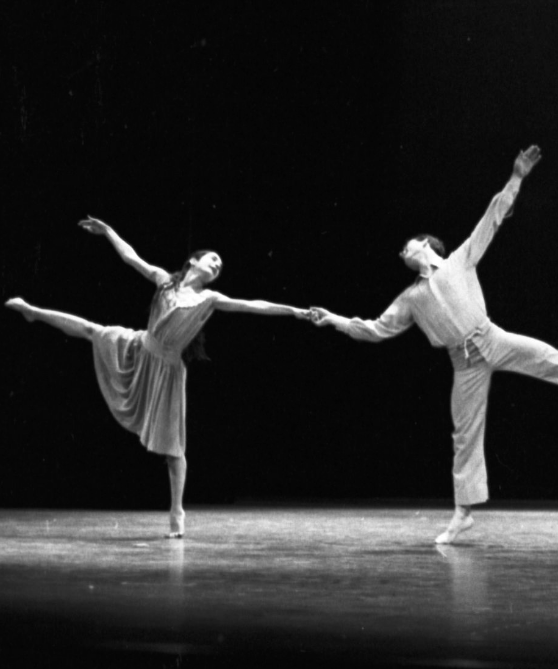
Posin and Larry Richardson in As I Lay Dying, 1964
Posin was cast in both Humphrey’s Passacaglia and Bettis’s As I Lay Dying (1952), based on Faulkner’s novel. Still a student at Bennington College, Posin played an innocent little girl to Larry Richardson’s little boy. Posin’s impression of Bettis was similar to that of Beals’s: “She was formidable. With her beautiful face, body, and voice, she was like an aging movie star, like Ava Gardner, Claudette Colbert, or Loretta Young.” Posin saw the choreography as generic modern dance that took second place to the narrative. “I was taught three hitch kicks, then grab Larry’s hand, like two children in the schoolyard. It was more about the theatrical meaning than it was about the movement itself.”
Both Jowitt and Posin noticed that Bettis had a drinking problem in the ’60s. “Valerie had a cane with a very ornate handle, like a knob,” Posin recalled. “She would unscrew it and drink from it.”
Dance Theatre of Harlem Re-stages Streetcar
While her career was winding down, Streetcar was revived by Dance Theatre of Harlem in 1982. Artistic director Arthur Mitchell explained his choice to Alan Kriegsman in The Washington Post:
No one’s done it in a while; it’s an American stage classic with box-office appeal; and because I visualized Blanche DuBois as an ideal vehicle for Virginia Johnson. Bettis and Fred Franklin did the staging for us; Bettis asked Tennessee Williams what he thought of the idea of doing it with an all-black cast, and he told her it was wonderful, fascinating.”
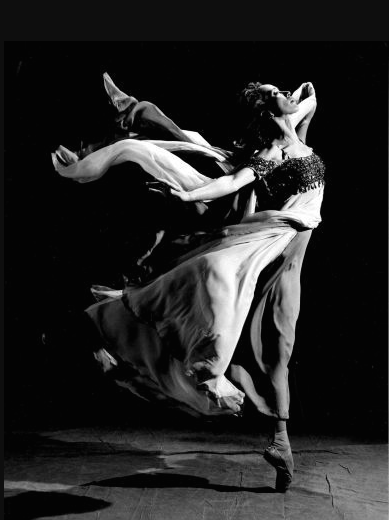
Virginia Johnson as Blanche in DTH’s production of Streetcar, 1982
For Virginia Johnson, the reigning star of DTH, working with Bettis opened up a new channel of expression. In a recent phone call, she called the process “fun, but really intimidating.” She remembers one particular day in the studio:
She asked if I’d done my homework, and I thought my homework was the step. She wanted to know, Where am I coming from and where am I going, and what do I want in this moment —the acting questions—and it was a revelation. I love doing those dramatic works. It opened a door, and it was not hard any more because then I could stop apologizing that my arabesque wasn’t very high, or that I didn’t have the right x or the y. But I could think about what I wanted in that moment and use that movement to get to it.
Streetcar turned out to be a star vehicle for both principals: Johnson as Blanche and Lowell Smith as Stanley. Anna Kisselgoff praised both dancers as well as Bettis’s “absolute mastery” of characterization and atmosphere. Rose Ann Thom wrote about Johnson’s performance, “In her sensitive portrayal of Blanche DuBois, vulnerability and arrogance coexist in heightened confusion.”
In 1986, when Streetcar was made into an episode of “Great Performances: Dance in America” on Thirteen, Jennifer Dunning wrote,
Lowell Smith, a superlative dramatic dancer, explodes with a typically sure and nuanced passion that makes Stanley’s anger and desire vividly immediate . . . And Virginia Johnson gives one of those flamelike performances that give lie to her reputation as an almost exclusively lyric ballerina. All long, broken and stretching limbs, Miss Johnson is frighteningly intense as the mad and maddening Blanche DuBois.
The demands of the role of Blanche, along with the role of Lizzie Borden in Fall River Legend by Agnes de Mille, helped prepare Johnson for her triumphant, touching Giselle in DTH’s production of Creole Giselle in 1984. Johnson recently told me,
I couldn’t have done the mad scene in Giselle if I hadn’t done Streetcar and Fall River Legend. They [Bettis and de Mille] weren’t making ballets, they were telling stories. That’s what was so powerful. We were a neo-classical company and I loved it and it was great. But this is a whole other way of being onstage.
In Conclusion
Bettis’ s works were important in the past but their staying power is in doubt. Even Johnson, now the artistic director of DTH, said that she would not reprise Streetcar because it’s about “this poor broken woman,” adding, “I don’t know that it is a story that we actually need now.” Not to mention that the form of dance drama has lost currency here in the United States.
But that form was Bettis’s strength. She was in demand as one of the rare performing artists who blended dance and drama. She advocated whenever she could for the melding of the two disciplines.
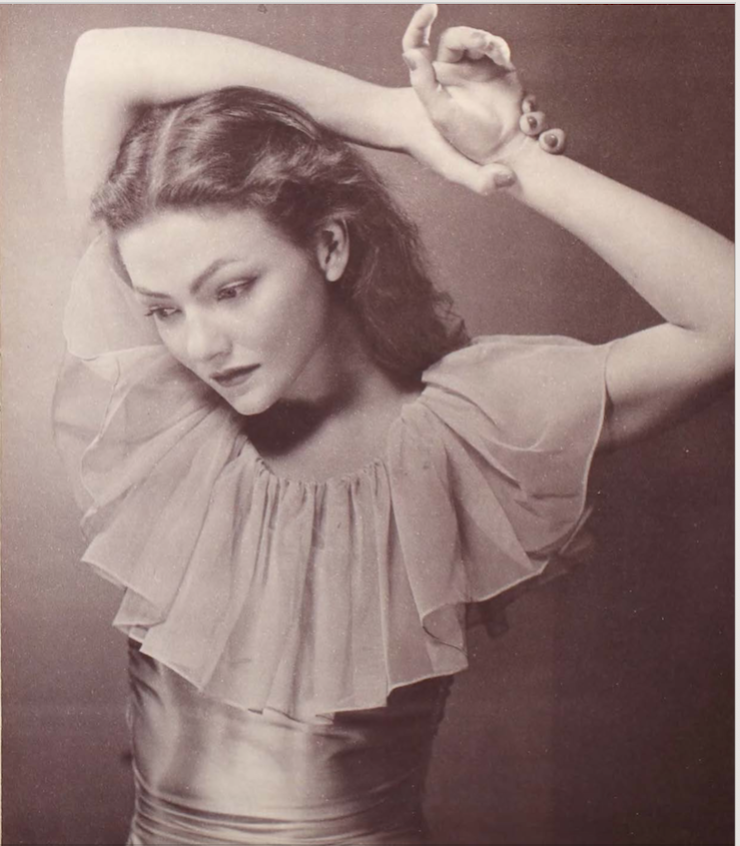
Bettis portrait, 1939, Dance Magazine Archives
Margaret Beals feels that Bettis made a huge contribution, that she created a niche that could have loomed larger in dance history. :
José Limón and Martha Graham divided the dramatic thing that came out of the ’30s and ’40s. Merce was making movement that’s valuable for itself, which is very important. In the crack of all that was Valerie, but she wasn’t a blow-her-own-horn person. She broke ground. She understood that movement has its greatest power when it tells a story. That a story by itself is nice, that dancing by itself is also very satisfying. But when, if you put together really good writing and really right movement, that’s pretty powerful.
¶¶¶
Special thanks to Norton Owen, Deborah Jowitt, Virginia Johnson, Margaret Beals, Kathryn Posin, and Khara Hanlon.
Other sources: Books
-
-
- The Borzoi Book of Modern Dance by Margaret Lloyd
- The Dance in America by Walter Terry, Harper Colophon Books
- Dance Writings of Edwin Denby
- The American Dance Festival by Jack Anderson
- Anna Sokolow: The Rebellious Spirit by Larry Warren
- Frederic Franklin: A Biography of the Ballet Star by Leslie Norton with Frederic Franklin
- Converging Movements: Modern Dance and Jewish Culture at the 92nd Street Y by Naomi Jackson
- The One and Only: The Ballet Russe de Monte Carlo by Jack Anderson
- Transcending Boundaries: My Dancing Life by Donald McKayle
- Wilde Times: Patricia Wilde, George Balanchine, and the Rise of New York City Ballet by Joel Lobenthal
Articles
-
- “Bravo; Valerie Bettis Choreographs a Novel Brilliantly—A Robbins Ballet” by John Martin, The New York Times, Jan. 16, 1949
- “Valerie Bettis Choreographs Streetcar Named Desire” by Doris Hering, Dance Magazine, Dec. 1952, p. 21
- “Ballet: Tortured Heroine” by John Martin, The New York Times, April 14, 1955
- “Valerie Bettis: Looking Back” by Herbert M. Simpson, Dance Magazine, Feb. 1977
- “Leaps and Bounds” by Alan M. Kriegsman, The Washington Post, Feb. 25, 1982
- “Valerie Bettis, Choreographer and Modern Dancer, Is Dead” by Jack Anderson Sept 28, 1982
- “Dance Theater of Harlem in Williams’s ‘Streetcar’ ” by Jennifer Dunning, The New York Times, Feb. 21, 1986
- “It’s Only That I Do What I Love and Love What I Do: Film Noir and the Musical Woman” by Adrienne L. McLean, Cinema Journal, Autumn, 1993, Vol. 33, No. 1, pp. 3-16
- “Dance Theatre of Harlem,” by Rose Ann Thom, Dance Magazine, July 1994
- “Bettis, Valerie: American dancer, choreographer, educator, and company director” by Herbert Simpson, Entry in International Dictionary of Modern Dance
- “Remodeling the Repertory” by Marcia B. Siegel, The Hudson Review, Summer 2015, Vol. 68, No. 2 (SUMMER 2015), pp. 301-308
Other media
- Oral History Project, streaming files, Jerome Robbins Dance Division, NY Public Library for the Performing Arts, Interviewed by Wendy Laakso, 1979
- Valerie Bettis papers, overview, NY Public Library, Archives & Manuscripts, (S) *MGZMD 42
- Hanya Holm: A Retrospective, directed and produced by Kathryn Sullivan, Alexander Street, 2011. Alexander Street, https://0-video-alexanderstreet-com.library.juilliard.edu/watch/hanya-holm-a-retrospective.
- Website: The Paley Center for Media
- Website: Bettis, Valerie Elizabeth (1919–1982), Biography entry, by Sherilyn Brandenstein, Texas State Historical Association
-
Thank you, Wendy!
Always wanted to know more about her. She was a mysterious figure to me after being in “Closed Door” 1961 (?) Juilliard, drawn from Sartre’s No Exit”
Sounds like an interesting work. I looked up Closed Door (as Juilliard faculty, I have access to digitized files) and found that the cast included you, Pat Christopher, James Payton, Joyce Trisler, Martha Wittman, Deborah Jowitt and others. A string quartet played the Webern Live. The date on the program is May 1959.
Excellent research on this dancer, choreographer, actress! I knew of her association with Hanya Holm, you have given us so much information!
And thank you for your wonderful documentary on Hanya Holm, from which I made a blurry screen grab. I was happy to see that minute of Valerie and Hanya dancing together. Do you think the caption, “In a Lighter Mood,” was the title of an actual duet, or just a reference to that afternoon of dancing together in the mountains?
This was such a great walk down memory lane for me. When I was a young girl 11-13, Portia Mansfield (of Perry-Mansfield Cámp and Theatre in Steamboat Springs CO fame) had me editing her films of Bettis (as well as José Limón) that she took at PM. Her films are at the Library for the Performing Arts at Lincoln Center, I believe. I was very fortunate to have been given scholarships by Portia to study with Florita Raupt at Hanya Holm’s studio, first in the Village and then at the Studio (I think it was called Michael’s) on 9th Avenue. Pearl Primus taught and rehearsed across the hall. It was always exciting to attend my class and also hear the drumming from the Primus rehearsals.
What a great memory! Many years before that, around 1938, Pearl Primus took her first dance class in the after-school dance club at Hunter College. The reason I know that is that my mother was the Hunter student who started the modern dance club. She saw Primus’ talent right away and told her to go the the New Dance Group.
Wendy, bravo. This is sensational, I would only add to the mix, from a Glenn Loney interview with Gwen Verdon concerning Jack Cole:
“He [Cole] would teach at Eugene Loring school [American School of Dance on Hollywood Boulevard], but he didn’t like the students, you know. If he had Valerie Bettis and people like [her] in class, he liked it but then when everybody else would come to class he didn’t like it. So he had me teach. He’d get bored.”
OH, this is great! Having a word about Bettis as a student makes such a difference. I guess Cole would agree with Hanya Holm, who thought of Bettis as a muse for a while. Thank you.
Hi Wendy…lovely to find out more about Valerie Bettis. Thank you. The second year I went to Jacob’s Pillow, Papa Shawn made a part staff position for me, as House manager and assisting the press officer, who brought up Valerie’s name many times. Sallie Jeter was herself from Nashville and perhaps followed Bettis’ career.
How great that you were at the Pillow while Ted Shawn was still around.
Valerie was my inspirational teacher for years 1960s – early 1970s. Thank you thank you for posting this. I knew her through our dance, how nice to learn more of her life and accomplishments